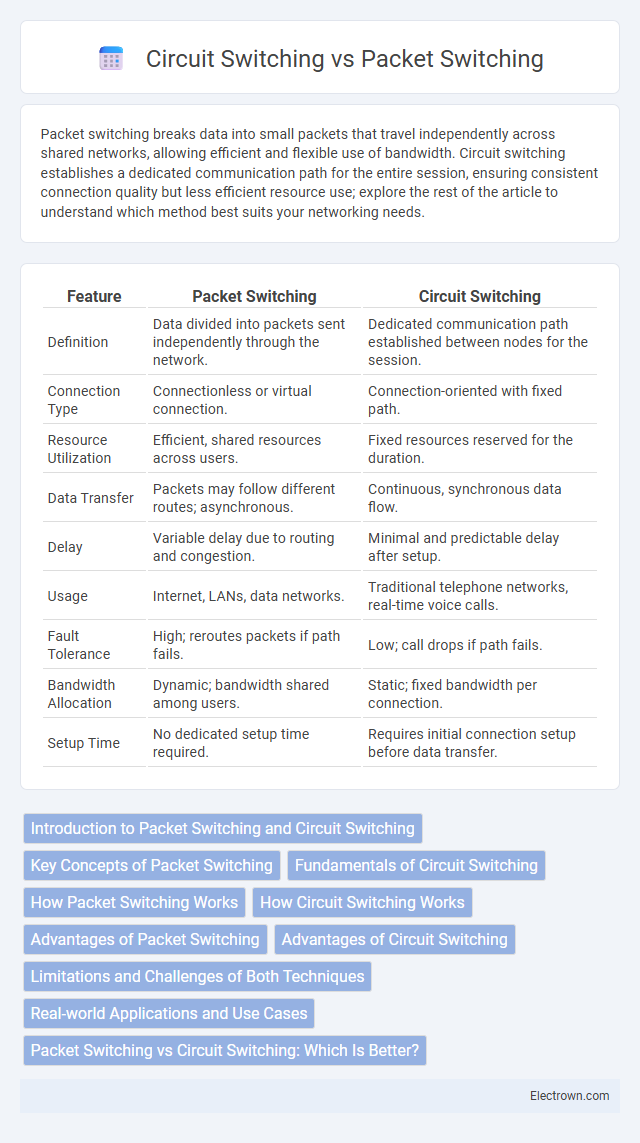Packet switching breaks data into small packets that travel independently across shared networks, allowing efficient and flexible use of bandwidth. Circuit switching establishes a dedicated communication path for the entire session, ensuring consistent connection quality but less efficient resource use; explore the rest of the article to understand which method best suits your networking needs.
Table of Comparison
| Feature | Packet Switching | Circuit Switching |
|---|---|---|
| Definition | Data divided into packets sent independently through the network. | Dedicated communication path established between nodes for the session. |
| Connection Type | Connectionless or virtual connection. | Connection-oriented with fixed path. |
| Resource Utilization | Efficient, shared resources across users. | Fixed resources reserved for the duration. |
| Data Transfer | Packets may follow different routes; asynchronous. | Continuous, synchronous data flow. |
| Delay | Variable delay due to routing and congestion. | Minimal and predictable delay after setup. |
| Usage | Internet, LANs, data networks. | Traditional telephone networks, real-time voice calls. |
| Fault Tolerance | High; reroutes packets if path fails. | Low; call drops if path fails. |
| Bandwidth Allocation | Dynamic; bandwidth shared among users. | Static; fixed bandwidth per connection. |
| Setup Time | No dedicated setup time required. | Requires initial connection setup before data transfer. |
Introduction to Packet Switching and Circuit Switching
Packet switching divides data into small packets that travel independently across a network, optimizing bandwidth and allowing multiple users to share the same communication paths efficiently. Circuit switching establishes a dedicated communication channel between two endpoints for the duration of a session, ensuring a constant and reliable connection suitable for real-time voice transmission. Understanding these fundamental networking methods helps you choose the right technology based on your data transfer needs and communication reliability requirements.
Key Concepts of Packet Switching
Packet Switching divides data into small packets that are transmitted independently across the network, allowing multiple users to share the same communication path efficiently. Each packet contains destination information, enabling dynamic routing based on network traffic, which enhances flexibility and reduces latency. Your data benefits from improved bandwidth utilization and fault tolerance compared to Circuit Switching's dedicated communication lines.
Fundamentals of Circuit Switching
Circuit switching establishes a dedicated communication path between two parties for the entire duration of the session, ensuring a constant and reliable connection. This method reserves network resources exclusively for the connection, minimizing delay and guaranteeing a fixed bandwidth. Understanding the fundamentals of circuit switching helps you recognize its suitability for real-time voice communication where consistent quality is critical.
How Packet Switching Works
Packet switching divides data into small packets that travel independently across a network, each taking the most efficient route to the destination. This method allows multiple users to share the same network resources dynamically, improving bandwidth utilization and reducing latency. Your data is reassembled in the correct order upon arrival, ensuring reliable communication even if individual packets take different paths.
How Circuit Switching Works
Circuit switching establishes a dedicated communication path between two endpoints for the entire duration of the connection, reserving the channel exclusively. Your data travels through this fixed route, ensuring a consistent and reliable transmission with minimal delay but limited flexibility. This method is the foundation of traditional telephone networks, where a continuous and uninterrupted signal is essential.
Advantages of Packet Switching
Packet switching optimizes network resource utilization by dividing data into small packets that travel independently, enabling more efficient bandwidth sharing compared to circuit switching's fixed path. This method enhances fault tolerance and flexibility, as packets can reroute around congested or broken links to maintain communication continuity. Your network benefits from reduced latency, scalability, and improved support for bursty data traffic, making packet switching ideal for modern internet applications.
Advantages of Circuit Switching
Circuit switching offers dedicated communication channels, ensuring consistent bandwidth and low latency throughout the connection. It provides reliable and predictable performance, which is essential for real-time applications like voice calls and video conferencing. The exclusive path eliminates congestion and packet loss, resulting in high-quality, uninterrupted communication.
Limitations and Challenges of Both Techniques
Circuit switching faces challenges like inefficient bandwidth use due to fixed, reserved paths and vulnerability to call blocking during high traffic. Packet switching, while maximizing resource utilization, encounters limitations such as potential data packet loss, latency issues, and the complexity of managing variable network congestion. Your choice between these methods should consider traffic patterns, quality of service requirements, and the trade-offs between reliability and flexibility.
Real-world Applications and Use Cases
Packet switching is widely used in Internet communications, enabling efficient data transfer for web browsing, email, and streaming services by breaking information into packets sent independently across networks. Circuit switching remains essential in traditional telephony and dedicated communication lines, ensuring a constant, reserved connection for voice calls and video conferencing. Your choice between these methods depends on whether you prioritize flexibility and scalability (packet switching) or guaranteed, uninterrupted data transmission (circuit switching).
Packet Switching vs Circuit Switching: Which Is Better?
Packet switching is better for data networks due to its efficiency in handling variable traffic and supporting multiple simultaneous communications by dividing data into packets routed independently. Circuit switching offers dedicated bandwidth and reliable, consistent connections ideal for real-time voice calls but is less efficient for bursty or data-heavy traffic. For modern internet and data transmission, packet switching outperforms circuit switching by maximizing network resource utilization and scalability.
Packet Switching vs Circuit Switching Infographic

 electrown.com
electrown.com